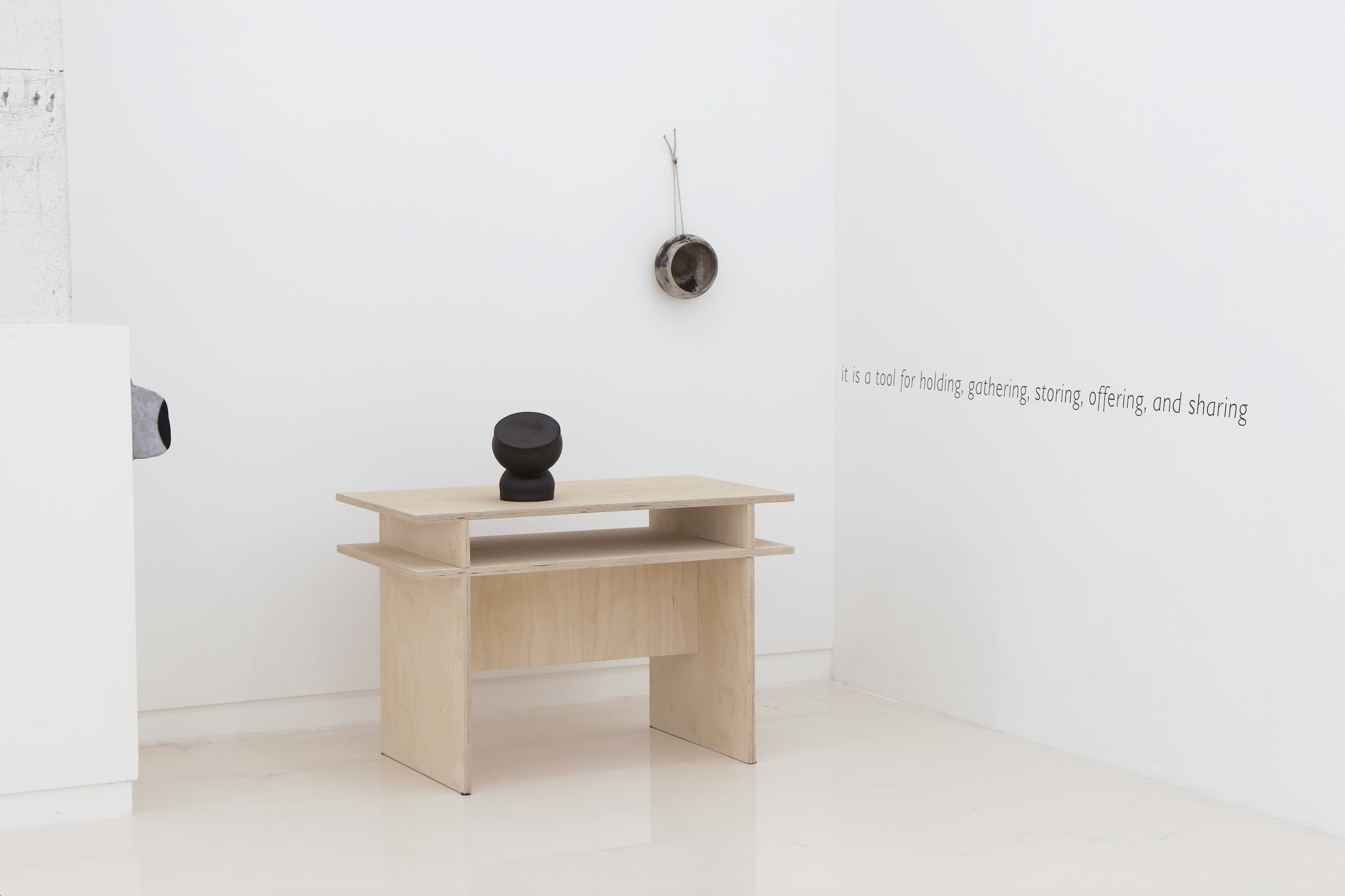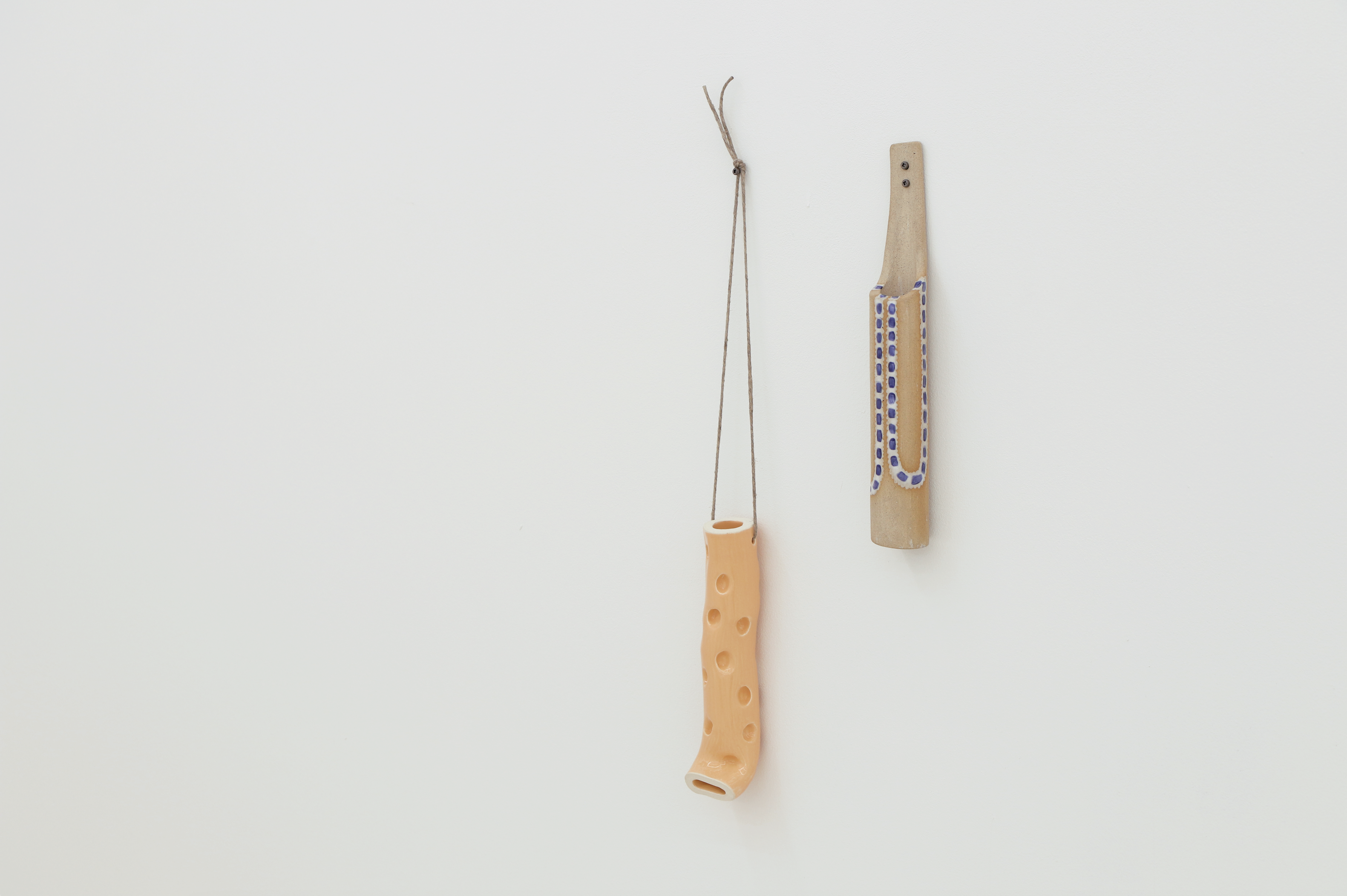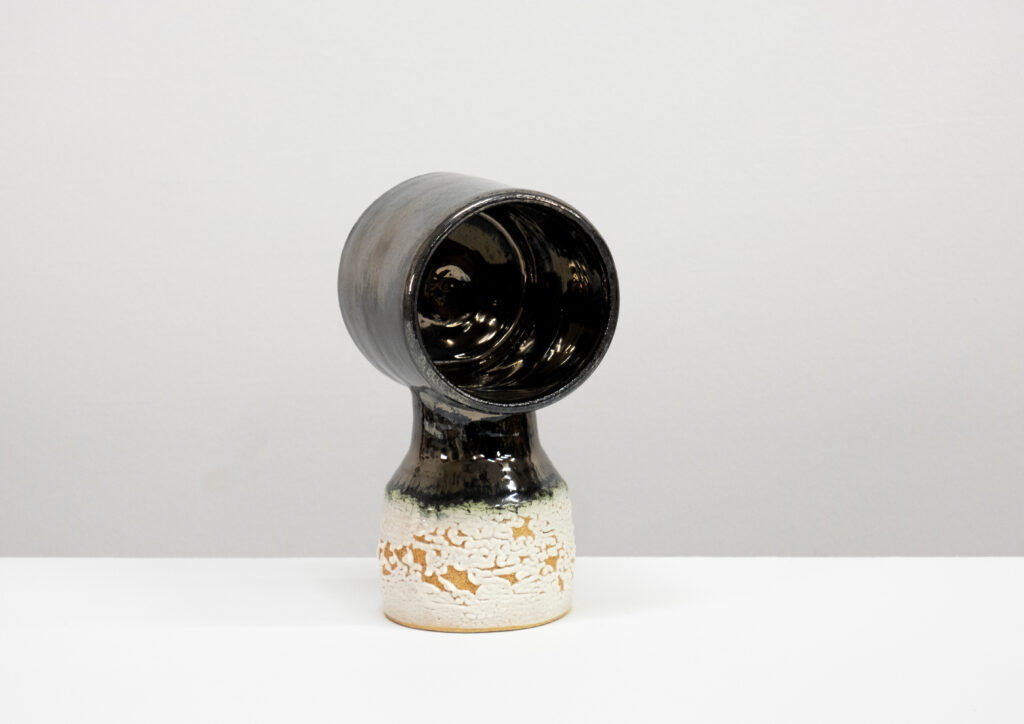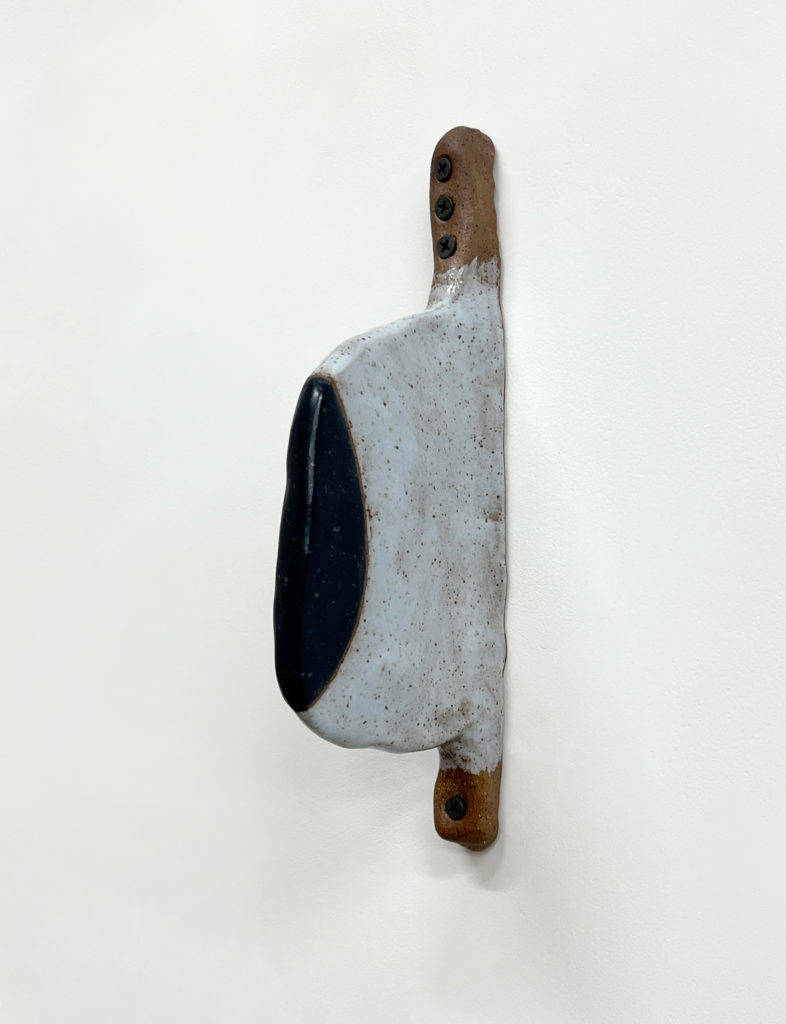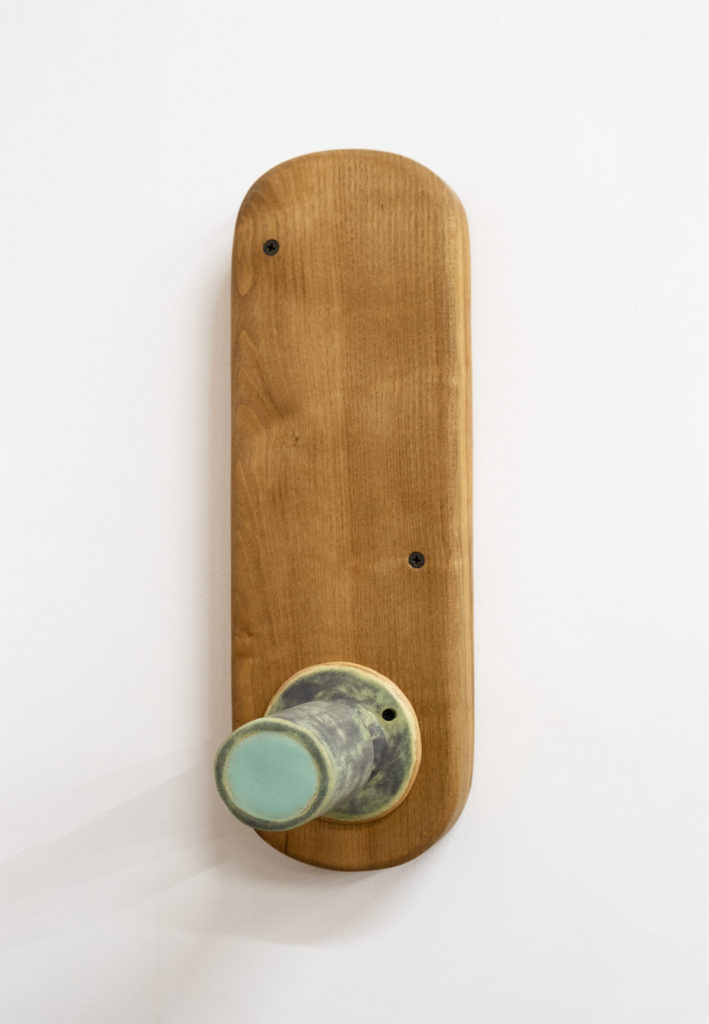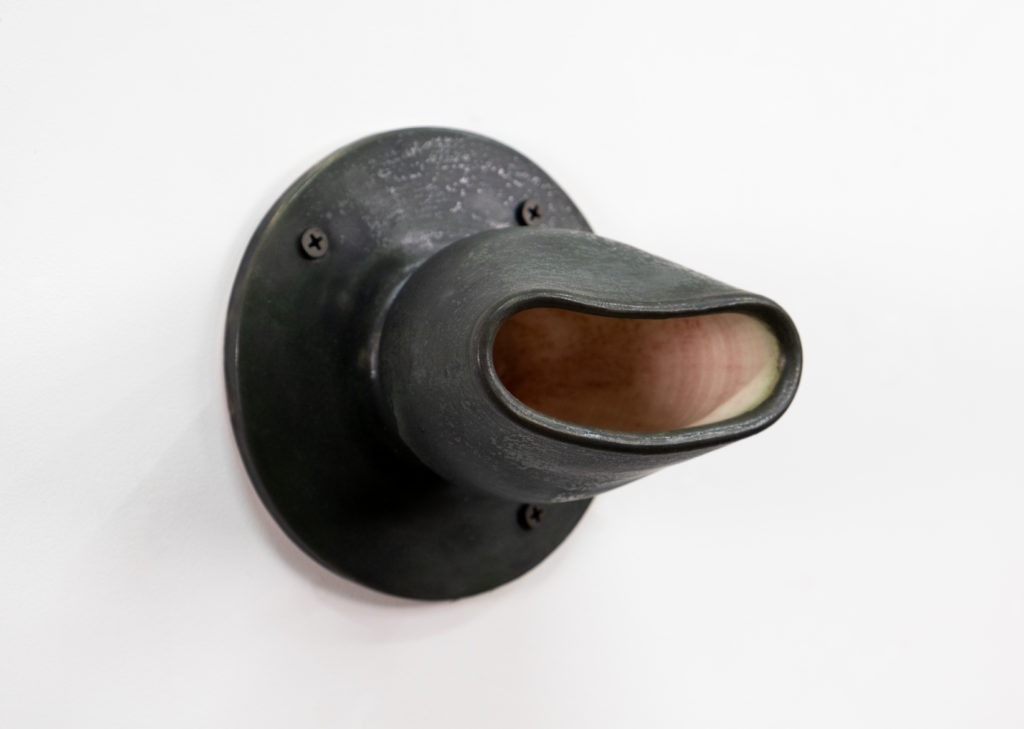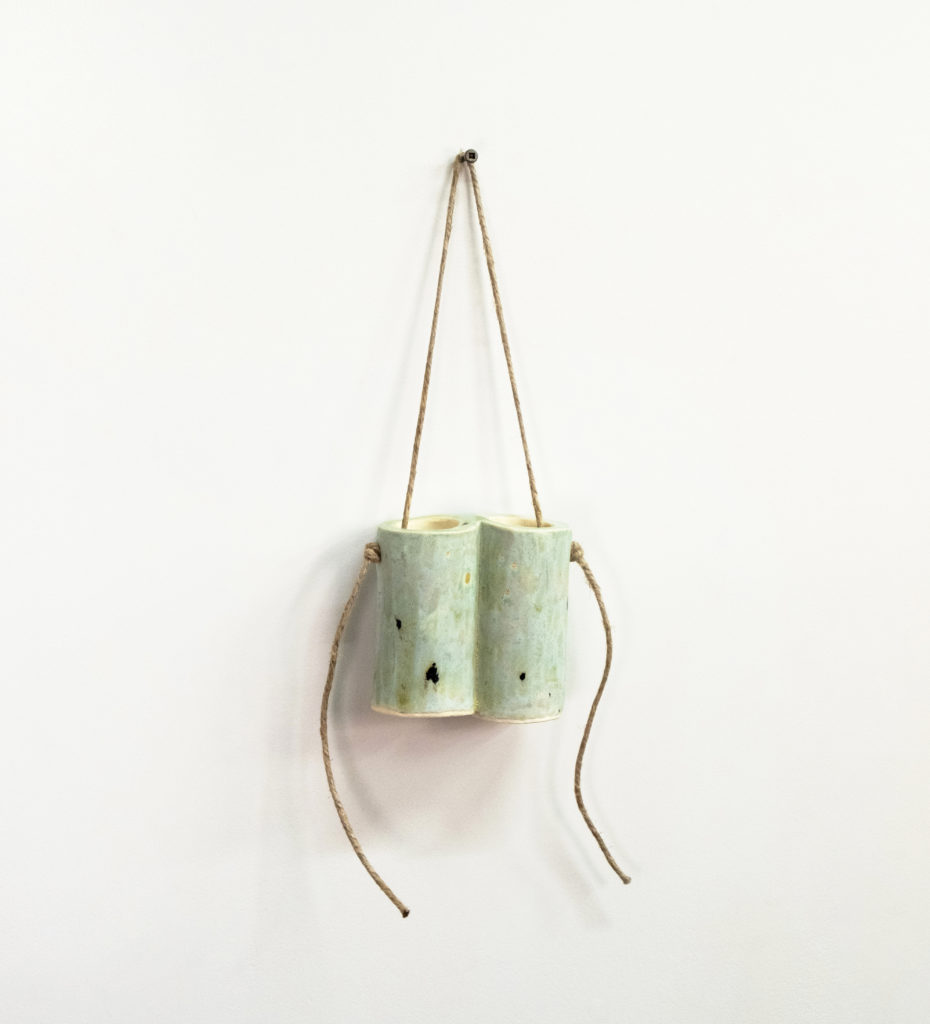ONE, TWO, HALF, NONE
A Solo Exhibition by Christina Tenaglia
Dec 2, 2023 - Jan 27, 2024
Wed - Sat, 11am - 6pm
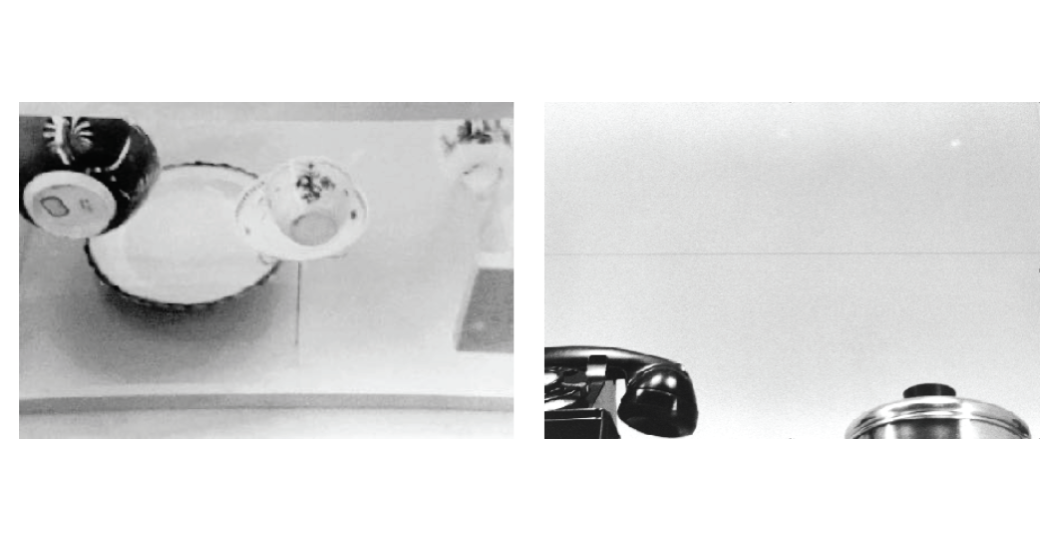
I took these photographs while in graduate school at Yale in 2003. They resurfaced recently, and I have been thinking about them a lot. They were, at the time, —and still are— essential to the development of my thinking: re-orienting objects and redefining object relationships.
I share them here because they feel so present in this work.
This past year, I have shifted from larger site-specific structures—temporary installations exploring home, shelter, structure, and place—to
the space we hold within our hands.
The starting point is a bowl
— a tool that is forever present, ancient, everyday, essential, human, simple, and necessary. It is a tool for holding, gathering, storing, offering, and sharing. Within this work, the ‘bowls’ shift shape and space, becoming cups, bottles, spoons, hands, pouches, pockets, baskets, packages… thumbprints.
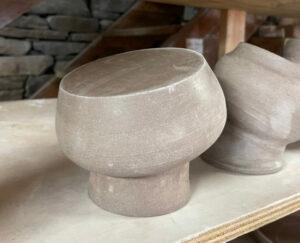
Clay is elemental, literally.
It is rock; it is earth; it is erosion.
At its most basic, it is silica, alumina, and water, with other elements mixed in to make a more complex clay body that can respond to pressures and stresses in different ways. It can be as immediate as digging it directly out of the ground by hand, but it also holds within in deep geological time and processes. We encounter it every day; we know how it feels in our hands but also in our mouths, under our feet, and next to our bodies.
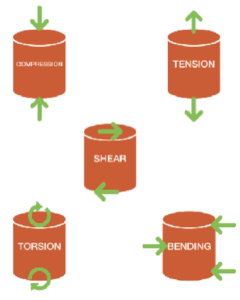
(This diagram is from a workshop I took on the chemistry —and physics— of clay.)
Its “making” is not a straight line: it undergoes constant stresses and pressures —the process as a whole is unstable. The immediacy of the first touch of clay is countered by a process of constant negotiation - forming, joining, drying, wetting, drying, waiting, caring for, and mending. From the moment clay enters our hands, it begins to undergo tension, compression, shear, torsion, and bending. But the clay also pushes back - it is feedback.
It is constantly responding to the conditions of its making.
Within its feedback, each piece feels like a microcosm of earth, of climate, of body, of collective action - holding and releasing pressure and responding to the forces that are acting upon it.
During the process of making,
two become one; one becomes halved, re-placed and joined.
The original objects are undone. Their use is turned in upon itself; containers are turned upside-down and sideways, closed, reopened, and given handles and holes, patches, and skins. A shelf bellies out into the shape of a sling.
Hands are present throughout: both implied and literally evident within the clay. The curve of a bowl, or a tube or a knob, offers an unspoken but understood hand placement. Some objects reach outward or upward, providing a handle, something to hold onto. The twine reveals a certain impermanence - an object or tool that is suspended, waiting—waiting to be picked up and used, movable and removable, hovering - but weighted. These hanging works are whole, but also segments, but also holes - elongated, bent, doubled, and bisected. Within an implied gesture of handling, the objects exhibit a kind of muteness -
a quietness but with a heightened sense of relationship, of awareness.
There are a limited number of gestures. Are there? But there are unknown and boundless ways that things shift into multiplicities, unnamables, and peculiarities.
Are abstractions disruptions? Are they ever-present moments of not knowing? Are they spaces for reconsideration? I am using elements that resist coming into a singular focus but offer familiarities, playing with uncertainties that allow for a more open and generative space, attempting to create the experience of unexpected bewilderment in something that is undeniably simple.
Christina Tenaglia

이 사진들은 내가 2003년 예일대학교 대학원 재학 중 찍은 것이다. 최근에 이 사진들을 다시 꺼내보게 되었는데, 많은 생각을 하게 되었다. 사물의 방향을 바꾸고 사물의 관계를 재정의하는 작업은 당시 내 생각의 전개에 필수적이었고, 이는 지금도 마찬가지이다. 이번 작업에서 이 관점들이 중요하기에 여기서 공유하고자 한다.
작년에 나는 집, 쉼터, 구조물, 장소를 탐구하는 설치물 등 장소 특정적인 대형 구조물 작업을 하다가
한 줌의 공간
으로 작업의 초점을 옮겼다.
출발점은 사발이었다.
언제나 존재하지만 고대부터 있던 것이고, 일상적이지만 본질적이고, 인간적이고, 단순하며, 꼭 필요한 도구이다. 사발은 담고, 모으고, 저장하고, 바치고, 나누는 도구이다. 이 전시를 위한 작업에서 사발은 컵, 병, 숟가락, 손, 파우치, 주머니, 바구니, 포장지... 지문이 되어 그 모양과 공간을 변화시킨다.

점토는 말그대로 광물질이다.
점토는 바위이고, 땅이며, 침식이다.
점토는 화학적으로 규소, 알루미늄, 물로 이루어져 있으며, 다른 원소와 섞으면 다양한 압력과 스트레스에 반응할 수 있는 더 복잡한 점토체가 되기도 한다. 점토는 손으로 땅을 직접 파내면 바로 얻을 수 있지만, 실제로는 가늠하기 힘든 지질학적 시간과 과정을 간직한 물질이다. 우리는 매일 점토를 접한다. 손 뿐 아니라 입, 발 밑, 몸 옆에서 어떻게 느껴지는지 알고 있다.

(이 도표는 점토의 화학과 물리학을 주제로 진행한 워크숍에서 가져온 것이다.)
점토로 '만들기'는 일직선의 간단한 과정이 아니다. 끊임없이 응력과 압력을 받는 과정 전반은 불안정하다. 점토를 처음 만졌을 때 즉각적인 촉감 다음에는 성형하고 결합하고 건조시키고 적시고 다시 건조시키고 기다리고 살피고 수선하는, 끊임없는 협상의 과정이 따른다. 점토는 우리 손에 들어오는 순간부터 장력, 압축, 전단, 비틀림, 구부러짐을 겪기 시작한다. 그러나 점토는 또한 저항하기도 하는데 이것이 점토의 피드백이다.
점토는 자신이 만들어지는 과정에 끊임없이 반응한다.
이러한 피드백 속에서 각 작품은 외부의 힘에 대한 반응으로 압력을 유지하고 방출하면서, 흙과 기후, 신체, 집단 행동이 응축된 작은 우주처럼 느껴진다.
만들기의 과정 속에서
두 개는 하나가 되고, 하나는 반으로 나뉘고, 다시 배치되고, 결합된다.
원래의 오브제는 형체가 사라진다. 원래의 용도가 반납되어 용기는 뒤집어지고, 옆으로 눕고, 닫히고, 다시 열리고, 손잡이와 구멍과 패치와 표면이 생긴다. 선반은 새총 모양으로 몸을 뒤집는다.
손의 흔적은 작업 과정 내내, 점토 속에서 암시적으로 또는 실제로 드러난다. 사발이나 관모양의 것, 손잡이의 곡선에서 두드러지지는 않지만, 손의 흔적이 감지된다. 어떤 물체는 바깥쪽이나 위쪽으로 뻗어 있어 손잡이처럼 잡을 수 있는 부분이 된다. 노끈은 임시성을 드러낸다. 사물이나 도구가 매달린채 기다리는, 즉 누군가 집어들어 사용되기를 기다리는, 옮길 수 있고 없앨 수도 있는, 공중에 떠 있는 상태, 그러나 무게가 있는 존재들이다. 이 매달린 작품들은 전체이기도 하지만 부분이기도 하며, 길쭉하고 구부러지고 두 배로 갈라지고 양분된 구멍이기도 하다. 다루어질 수 있다는 암시를 내포한 오브제들은 일종의 말없음, 즉
관계와 인식에 대한 감각이 고조된 상태의 정적
을 드러낸다.
제스처의 수는 제한되어 있다. 그런가? 하지만 하나의 사물이 여럿이 되고, 이름 붙일 수 없는 것, 특이한 것으로 변화하는 방식은, 알려지지 않은 무한한 방식이 있다.
추상은 혼란을 주는 것인가? 계속되는 “모름”의 순간일까? 다시 생각하게 되는 공간일까? 나는 초점을 정확히 맞출 수는 없지만 익숙한 요소를 사용한다. 개방적이고 생성적인 공간을 만들어내는 불확실성을 추구하며, 극도의 단순함 속에서 예상치 못한 당혹감을 경험하게 하기 위한 시도들을 하고 있다.
크리스티나 테나글리아


